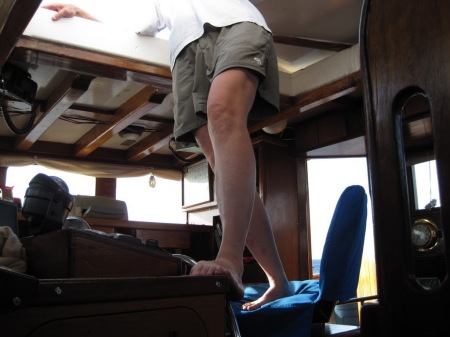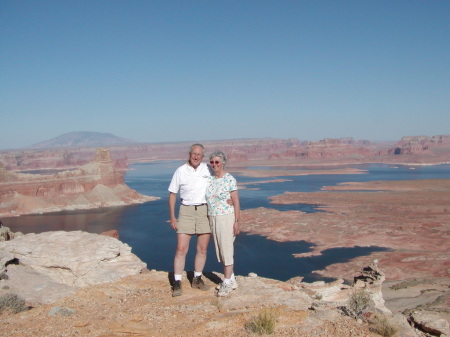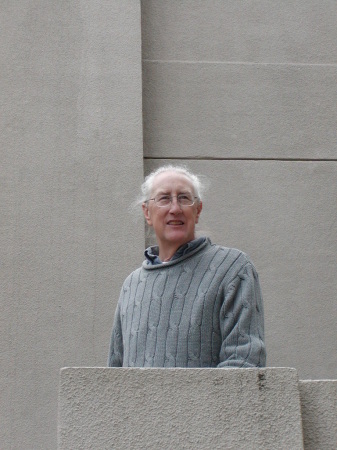Steven Greene:
CLASS OF 1969

Evergreen High SchoolClass of 1969
Evergreen, CO
Steven's Story
UPDATE 2021
Who'd have guessed that, after being so indifferent with math and physics at EHS, I'd have attained a Ph.D. in Physics? After EHS I attended CU, first in Denver and then in Boulder. I worked my way through CU Boulder at the university's Nuclear Physics Laboratory, operating a cyclotron and building/doing experiments with the staff, grad students, and post docs.
While there, I was president of the local chapter of the Society of Physics Students and Sigma Pi Sigma. I was also a member of the service fraternity Alpha Phi Omega. Living both on and off campus was a great time - the most fun for the least money I ever had, including class. Skiing, rock climbing, swimming, scuba, and figure skating were my favorite sports. The CU Physics Department sent me to Los Alamos Scientific Laboratory in New Mexico for the summers to help build the experimental facilities for the new linear accelerator they were building as the flagship facility for the US nuclear physics program.
After taking a BA degree from CU in 1975, the university hired me as a research physicist to be stationed at Los Alamos. After a year there I had been recruited by a number of grad schools and started at the University of Texas in Austin in 1976. I accepted there because they would let me continue conducting the research we were starting at the unique Los Alamos facilities. I conducted many experiments with scientists from all over the world. My dissertation focused on developing and using an apparatus to investigate the last, unexplored, class of direct pion interactions, the pion double charge exchange reaction. Previous attempts had been either completely unsuccessful or returned wildly discrepant results. Theory predicted either zero or extremely small strength for these reactions. My apparatus was highly successful and opened these reactions for use in both nuclear reaction and nuclear structure studies.
Before finishing my doctorate (in 1981) I was recruited by various universities for post-doctoral positions (UCLA, MIT...). I accepted at New Mexico State University because they let me both continue to explore the pion work I had done, but also work with other national and international laboratories on exploring fundamental interactions between pairs of protons and neutrons, the nucleon-nucleon system. These forces must be understood, and how they are modified by the presence of additional nucleons, to understand the atomic nucleus.
After a year as a post-doc, and finishing my dissertation for the Ph.D. at UT, I was promoted to Assistant Professor at NMSU. All this time I still lived and worked in Los Alamos. About a year after that I was recruited to join the research staff at Los Alamos National Laboratory to continue doing the work I was already engaged in, but also to take on leadership roles in some of the various projects our research division was involved in. The Laboratory was operated by the University of California for the US government, so now I was a technical staff member of one of the most energetic research programs in the world. We worked with folks from all over the world, doing scores of important experiments in basic and fundamental nuclear science. We ran experiments 24/7, for up to 9 months a year. I was scientific advisor for a number of grad students from various universities and sat on many of their examination committees.
Great times! Los Alamos sits at 7000'+ in the Jemez Mountains outside Santa Fe. Excellent outdoor recreation and fabulous cultural activities deriving from the mix of Anglo, Hispanic, and Native American cultures and the Arts. (I remember running into one of our EHS teachers, Susan Hagen, at the Santa Fe Opera one summer.)
I met and courted a lovely lady in 1984 and married her in 1985. We both had exciting, demanding work, and a great environment for doing it. As an example, in 1991 we spent five weeks in the Soviet Union. I was invited to lecture at a number of institutions across Russia and Ukraine as a guest of the Soviet Academy of Sciences. They invited Ann to accompany me to talk with institute staff about the use of integrated software business systems to help manage their businesses. There was an attempted coup against the leadership of Mikhail Gorbachev during that time, which was put down. It did not affect us and our activities, but we did find ourselves among quite a reduced number of westerners for a while, as others fled or cancelled visits. It is a vast country, heavily forested in many areas. We were hosted to a number of banquets and cultural events and venues in Moscow, St. Petersburg (just changing from Leningrad), Kiev, Kharkov, Dubna, Troitsk, Pushkin, and such. Traveling across country by train was lots of fun. We had an hilarious adventure getting out of the SU when our air carrier, Pan Am, went bankrupt and stopped flying. Briefly, we caught the very last Pan Am flight out of Moscow, and the very last Pan Am flight out of Europe (Frankfurt), lest we be stranded for weeks. I would return to Russia years later to review work being done by Russian colleagues on aspects of applied physics similar to work I was leading at Los Alamos and elsewhere. Despite their years of coping with the Soviet system they were still very able physicists.
In the mid 90's the emphasis in the national nuclear physics program shifted fro...Expand for more
m hadronic interactions to electro-weak interactions and to heavy-ion interactions looking at quarks. Our effort here downsized and I transferred to the LANL Physics Division Office, working for the Division Leader, managing division operations.
While in the division office I worked closely with LANL senior management and Department of Energy officials (DOE "owns" the Laboratory) to revamp the process the government uses for selecting the contractual requirements its contractors (such as the University of California) must follow when operating government facilities (such as Los Alamos). I spent a lot of time in Washington, DC, working with senior DOE managers and research and operations staff from across the country. Lots of week-long trips, both to DC as well as to other sites around the country. We developed a new process and received a "Re-Inventing Government" award from Vice President Al Gore. I also led or worked on teams at Los Alamos to re-invent our internal governance structure and regulations. These were well received.
In 2000 the Cerro Grande forest fire devastated Los Alamos, destroying over 400 homes. Ours included. Total destruction of all we owned. We were driven out of our homes, evacuating the town, on Wednesday just after noon. By dark the western neighborhoods were all ablaze. The entire county was evacuated. We stayed with friends in Santa Fe for about 10 days and then were able to find a lovely place to rent in the foothills of the Sangre de Cristo Mountains north of Santa Fe. But even with our home in ruins, the Lab asked me to be one of a small bunch of staff to return to the off-limits county and Lab to invent processes to allow safe and secure re-entry of the Laboratory, to evaluate and correct all hazardous safety and security conditions that might have arisen from the fire and its affects. Still, with all of that, Ann and I realized after about three weeks that home was wherever we were - the house and stuff was secondary. We had each other and our abilities unimpaired - a true blessing.
We decided to stay in Los Alamos. We worked with architects to design and build an award-winning new house on a rocky end of a mesa surrounded by canyons and overlooking the Rio Grande Valley, land we had owned for a while. We have views past Taos to the north and past Albuquerque in the south, and the long stretch of the Sangre de Cristo Mountains, on the east across the Rio. The house as been used as a set for the movie "Haywire" and for the "Longmire" TV series. We had to move four times during the course of construction. (Of course, we did not have much to move:) Parts of our former neighborhood are still being rebuilt (even 16 years later). We sold our original house site to friends who were burned out up the street and they built a lovely house on the site.
I have since returned to research. We are using many of the techniques we developed for our basic nuclear research, now in applications aimed at issues of trying to detect attempts at smuggling nuclear materials such as uranium and plutonium, or hidden explosives. Our work has evoked a lot of interest for applications in defense and homeland security. We have developed a method to use the subatomic particle the muon, coming naturally from cosmic rays, to image the insides of very dense or thick structures. This is currently being deployed to image the insides of the crippled Fukushima Reactors in Japan. We can build a 3-D image using stationary detectors outside the reactor buildings. We are preparing another effort with this technology to image the internal structure of the great dome of the cathedral in Florence, Italy. The dome was built in the 1400's and is in a seismically unstable region.
I retired from the Laboratory in 2012 but continue on as an associate to work with both the team I led in threat reduction research as well as issues affecting current and future research (same office...). Even though I am only sometimes paid it is still an honor to contribute to the security and betterment of our nation. In recognition of the great opportunities afforded by my education at the University of Colorado I have endowed a scholarship in the Physics Department there.
We do visit Evergreen occasionally, seeing old college friends who live in the area and family acquaintances. Several colleagues from here have retired to the area. We travel frequently in our EarthRoamer expedition vehicle off-road in the southwest and as far afield as the Carolinas. We have sailed 40' class sloops extensively in the Windward and Leeward islands of the Caribbean, even catching them doing scenes for the Pirates of the Caribbean movies. The classmates picture is me helming a 101' schooner. We are both active with the Los Alamos Historical Society and I am a physicist resource and docent for the Manhattan Project National Historic Park.
My parents retired in the East Bay area near San Francisco (Mom died in 2014, Dad in 2017). My brother Dan is retired from nuclear power in South Carolina. Eldest sister Kate is a retired Dentist/Endodontist in Sacramento; mid sister Sandy lives in Pleasanton, east of the south San Francisco Bay; youngest sister Gretchen lives and works in Scottsdale, AZ. We're grandparents to our daughter's two young children, currently in North Carolina, and to our son's son in St. Louis.
Register for Free to view all details!
Reunions
Register for Free to view all events!
Photos



